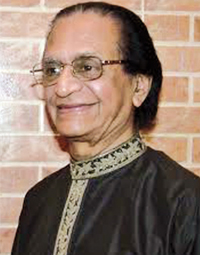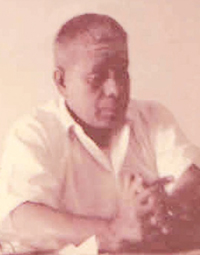COVER STORY
Nagaswaram traditions and lineages
T. SANKARAN

[Edited excerpts from a lecture delivered at a seminar for the Institute of Traditional Cultures, Chennai, in 1986.] Is it nagaswaram or nadaswaram? Much can be said on both sides, but a rose is a rose by any other name. It is also referred to as naayanam, evidently from the analogy to nayanam or the eye, thus stressing the ubiquitous nature of this auspicious instrument, indispensable to the performance of religious and social rites from womb to tomb. There is no temple that does not have a nagaswaram band, irrespective of the degree of its aesthetic sensitivity. India is a land of villages. Koyil illa ooril kudiyirukka vendam, goes a well known adage It means that a village sans a temple is unfit for human habitation; and the nagaswara vidwan, ill paid and half starved, is complementary to the temple. Tamil Nadu, particularly the Tanjore district, is flooded with the Isai Velalar community providing upacharam to the local deity as members of the Peria Melam or all-male nagaswaram band and the Chinna Melam or troupe of female dancers and their male accompanists. This was the sampradaya in Tamil Nadu society in the 1930s and 40s. Political and social upheavals have opened the doors of this terpsichorean world to other communities in India and abroad and also to both sexes. The provision of educational and employment concessions to this ‘most backward class’ of Isai Velalars (literally, cultivators of music and dance) has lured the Isai Velalars to holier callings than temple service.
SAVAL-JAVAB
“The margam must not become obsolete”
PROF. C.V. CHANDRASEKHAR IN CONVERSATION WITH ANJANA ANAND

A tall, distinguished man with a scholarly air walks into a sabha, to be immediately surrounded by eager young artists waiting to welcome him. We immediately notice his erect posture and elegant kurta as he smiles and greets the crowd around him. All his real life roles – of academician, dancer, musician, choreographer and teacher – are reflected in that one confident stride. Professor C.V. Chandrasekhar quietly slips into the hall where a young dancer is performing and takes his seat cringing at the fanfare his entrance has caused. A Padma Bhushan awardee (2011), Professor Chandrasekhar retired from the M.S. University, Baroda, as Head of the Department of Performing Arts in 1992. Since then, several prestigious awards have followed – the Central Sangeet Natak Akademi award, Kalidas Samman, Nadabrahmam, and Sangeeta Kala Acharya, to name a few. Little did he know as a young M.Sc Botany student that he would one day be a beacon light in the Bharatanatyam world. Not only is Prof. Chandrasekhar one of the first few male Bharatanatyam dancers to dedicate their lives to art, but he has three talented women to share his artistic space – his wife and dance partner Jaya Chandrasekhar, and his daughters Chitra Chandrasekhar Dasarathy and Manjari Rajendra Kumar, who are established performers known for their creative and intelligent approach to the art form. If you happen to walk into his home in Chennai you cannot miss the friendly discussions on art going on between the dancing couple and their daughters.
IN MEMORIAM
Raghunath Panigrahi
SHYAMHARI CHAKRA

Date: 21 February 2010. Venue: Konark Dance and Music Festival Suramani Pandit Raghunath Panigrahi, recipient of the Padma Shri, was invited on stage to present the Sanjukta Panigrahi memorial award to vidwan M. Balamuralikrishna. Panditji went on stage, touched the feet of the living legend and said, “You are an older brother to me. At the All India Radio, Madras, you were the producer and I was working under you.” Instantly, Balamuralikrishna touched Pandit Panigrahi’s feet, evoking awe amongst us and said, “I was senior to you in an official manner, but, in music matters, you are above me”. Raghunath Panigrahi passed away quietly in his homeland of Odisha on 25 August 2013. He was not just the better half of Odissi legend Sanjukta Panigrahi, nor was he just an Odissi musician – he was far beyond that. Raghunath Panigrahi, was arguably, the lone musician to have a grip over India’s three distinct music traditions – Carnatic, Hindustani and Odissi. He was the only non-South Indian to lend his voice for Telugu, Kannada, Tamil and Malayalam movies as a playback singer. He trained living legends like K.J. Yesudass and Ilaiyaraaja. Way back in 1982, he was conferred the coveted Grand Prix Award from France for his contribution to Indian music. And, together with his dancer-life partner, he was India’s first artist-couple to share the prestigious Central Sangeet Natak Akademi award in 1976. Raghunath was born in the non-descript Gunupur town of Odisha on 10 August 1934. Music flowed in his veins. His father Pandit Nilamani Panigrahi was an exponent of music, besides being an authority in Sanskrit, Odia and Telugu languages and literature. He was Raghunath’s first music teacher. The child was very fond of singing and an astrologer had predicted to his mother that he would become a musician. That prediction came true quite early in his life.
REAR WINDOW
K.C. THYAGARAJAN - A versatile composer
SUJATHA VIJAYARAGHAVAN

It came as a surprise to me to read that K.C. Thyagarajan, a music composer of rare merit, had composed all the songs of Meenakshi Vijayam in a single raga for Rukmini Devi, when she requested him to compose it for a dance-drama. (Sruti 343, The Making of Meenakshi Vijayam by Gowri Ramnarayan). Surely there must have been a communication chasm between Thyagarajan and Rukmini Devi, for I have been fortunate to have seen and heard this man’s creative genius in action on several occasions. He was a scholar in Tamil and probably well versed in Sanskrit, Telugu and other languages. He loved Tamil literature and had a deep knowledge from the Sangam age to Subramania Bharati and had set several pieces to music. Some of them were recorded by AIR-Madras and were broadcast frequently in their delectable Tamizh Manam programme in the mornings. The Mukkoodar Pallu song Aattru vellam nalai vara totruthe kuri in Navarasa Kannada, sung by Seetha Subramanyam with another singer, is an example of how a Carnatic raga could metamorphose into a light and airy folk melody. We could almost see the two maidens in the lyrics clapping and skipping in joyful anticipation at the lightning heralding the arrival of the surging waters of the river.


